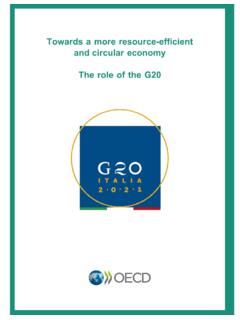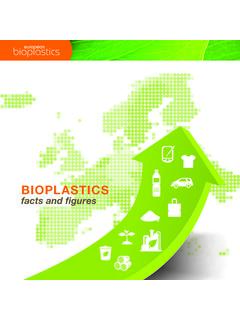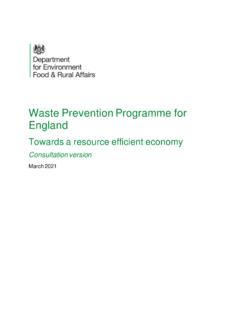Transcription of How to produce a Green Plan: A three-year strategy towards ...
1 1 | Contents Contents 1. Introduction .. 2 2. Developing a trust or ICS Green Plan .. 3 3. The structure of a Green 5 4. The foundations of a Green Plan .. 9 5. Green Plan governance .. 10 6. Tracking and reporting progress .. 12 7. Supporting resources .. 13 8. Key messages and conclusion .. 15 2 | 1. Introduction 1. Introduction In October 2020, the Greener NHS National Programme published its new strategy , Delivering a net zero National Health Service. This report highlighted that left unabated climate change will disrupt care, with poor environmental health contributing to major diseases, including cardiac problems, asthma and cancer. The report set out trajectories and actions for the entire NHS to reach net zero carbon emissions by 2040 for the emissions it controls directly, and 2045 for those it can influence (such as those embedded within the supply chain).
2 To support the co-ordination of carbon reduction efforts across the NHS and the translation of this national strategy to the local level, the 2021/22 NHS Standard Contract set out the requirement for trusts to develop a Green Plan to detail their approaches to reducing their emissions in line with the national trajectories. Given the pivotal role that integrated care systems (ICSs) play, this has been expanded to include the expectation that each system develops its own Green Plan, based on the strategies of its member organisations. Having replaced the previous Sustainable Development Management Plans (SDMP) in 2020, the new suite of Green Plans is expected to match the increased net zero ambition and renewed delivery focus, with three clear outcomes: ensure every NHS organisation is supporting the NHS-wide ambition to become the world s first healthcare system to reach net zero carbon emissions prioritise interventions which simultaneously improve patient care and community wellbeing while tackling climate change and broader sustainability issues support organisations to plan and make prudent capital investments while increasing efficiencies.
3 This guidance explains how NHS organisations should construct their Green Plans, and the areas and initiatives that the plans should cover. 3 | 2. Developing a trust or ICS Green Plan 2. Developing a trust or ICS Green Plan Green Plans provide a structured way for each trust and ICS to set out the carbon reduction initiatives that are already underway and their plans for the subsequent three years (for this cycle, 2022/23 to 2024/25). A three-year timeframe should allow Green Plans to strike an appropriate balance between immediate carbon reductions in some areas, alongside strategic development of capability in others. In all cases, Green Plans should reflect national priorities by aligning with the plans, actions and timescales laid out in Delivering a net zero National Health Service.
4 Every trust and every ICS is expected to have a Green Plan approved by that organisation s board or governing body. For trusts, these should be finalised and submitted to ICSs by 14 January 2022. Each ICS is then asked to develop a consolidated system-wide Green Plan by 31 March 2022, to be peer reviewed regionally and subsequently published. These ICS strategies should summarise the Green Plans of relevant member organisations, while also commenting on system-wide priorities and co-ordination. They should also focus on the integration of trust Green Plans with the efforts of primary care, local authorities and other local care partners. In developing a Green Plan, each organisation should: review progress since the organisation s last Green Plan (or equivalent), to determine what facets have worked well and which need renewed focus or a different approach take into account the national targets (and interim 80% carbon reduction goals) for the NHS carbon footprint and carbon footprint plus, as well as learning from trusts which are already aiming to exceed these ambitions engage widely with internal stakeholders and key partner organisations to inform sustainability priorities and identify areas for productive collaboration 4 | 2.
5 Developing a trust or ICS Green Plan develop and refine SMART (specific, measurable, achievable, relevant and time-bound) actions focused on early efforts to directly reduce carbon emissions develop systems and processes to measure and report on progress against plans and commitments, annually. Green Plans are not currently required for non-NHS organisations delivering health or social care, although this template and guidance can certainly be applied to those settings if useful. Organisations which have produced a Green Plan, SDMP or similar recently (published in 2019/20 or 2020/21) will not need to draft a new Green Plan until the three-year cycle is complete. However, these organisations are encouraged to review and potentially update these plans in light of this guidance and the Delivering a net zero National Health Service report, and then to focus on accelerated delivery of their existing plans.
6 5 | 3. The structure of a Green Plan 3. The structure of a Green Plan The shape and structure of Green Plans will vary by organisation, depending on local context, work delivered to date and local priorities. Allowing for this variation, the chapters of Delivering a net zero National Health Service provide a useful outline for the structure of a Green Plan, ensuring each trust and ICS has a comprehensive strategy that addresses all of the major sources of carbon emissions. Some organisations may choose to add additional chapters such as those focused on improving air quality or reducing plastic waste based on their own sustainability priorities. To this end, the example chapters shown below should not necessarily be considered exhaustive. Introduction Introduce your organisation, including the number of employees, key services provided, size, configuration, geography and any other pertinent background information to set the context for the Green Plan.
7 This should also include pertinent demographic and socioeconomic details of the local populations served. Organisational vision Set out your organisation s vision and priorities for carbon reduction and sustainable development. When considering your organisational vision, it may be worth reflecting on the following questions: Which environmental, financial and social issues are most important to the communities and people your organisation serves? What specific improvements would most benefit your local communities, staff and the overall organisation? 6 | 3. The structure of a Green Plan Which specific actions and initiatives will your organisation prioritise over the next three years to lay strong foundations for your longer-term net zero strategy ? Areas of focus This section outlines the core chapters of a Green Plan, aligned to the main drivers of change and sources of carbon emissions across the NHS.
8 Workforce and system leadership: This chapter should set out your approach to engaging and developing your workforce and system partners in defining and delivering carbon reduction initiatives and broader sustainability goals, where appropriate. It may cover the operation of sustainability committees and working groups; development of online sustainability training and pledge platforms for staff; and investment in specific staff to support sustainability goals. Sustainable models of care: Embedding net zero principles across all clinical services is critical, with this section considering carbon reduction opportunities in the way care is delivered. Examples may include the provision of care closer to home; default preferences for lower-carbon interventions where they are clinically equivalent; and reducing unwarranted variations in care delivery and outcomes that result in unnecessary increases in carbon emissions.
9 Digital transformation: The direct alignments between the digital transformation agenda and a net zero NHS are clear. This section seeks to focus on ways to harness existing digital technology and systems to streamline your service delivery and supporting functions while improving the associated use of resources and reducing carbon emissions. Examples could include a consideration of expanding the use of telemedicine to deliver some care remotely and using digital systems to reduce the use of paper records, printing and postage. 7 | 3. The structure of a Green Plan Travel and transport: This chapter should outline plans to reduce the carbon emissions arising from the travel and transport associated with each organisation. It should explore interventions to reduce carbon, by: increasing levels of active travel and public transport investing in ultra-low emission and zero-emission vehicles for owned and leased fleets maximising efficiencies in the transport of goods and services commissioned by the organisation, such as patient transport, courier services and deliveries.
10 Estates and facilities: The chapter should focus on reducing the carbon emissions arising from the organisation s buildings and infrastructure, including: improving energy efficiency and reducing energy usage decarbonising heating and hot water systems waste reduction and the circular economy building design and refurbishments. Medicines: This chapter should examine the key opportunities to reduce the carbon emissions related to the organisation s prescribing and use of medicines and medical products. Areas of focus could include medicines optimisation and reducing waste ; responsible capture or disposal of waste medicines and considering lower carbon alternative medicines. The 2021/22 NHS Standard Contract set out inhalers and anaesthetic gases as two key areas for early action in this area, and so every Green Plan should cover these two areas of focus within this chapter.












